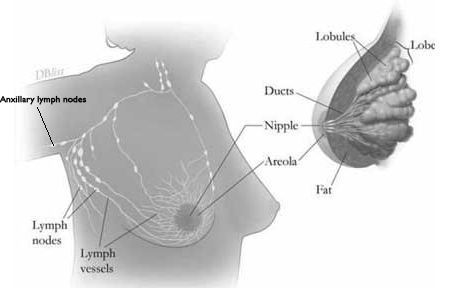
The breast is a mass of glandular, fatty, and fibrous tissues positioned over the pectoral muscles of the chest wall and attached to the chest wall. A layer of fatty tissue surrounds the breast glands and extends throughout the breast. The fatty tissue gives the breast a soft consistency.
The breast is responsive to a complex interplay of hormones that cause the tissue to develop, enlarge and produce milk. The three major hormones affecting the breast are oestrogen, progesterone and prolactin, which cause glandular tissue in the breast and the uterus to change during the menstrual cycle.
The glandular tissue of the breast consists of lobules (milk-producing glands at the ends of the lobes) and ducts (milk passages). During lactation (breastfeeding), the lobules fill with milk which then flows along the ducts leading to the nipple. Toward the nipple, each duct widens to form a sac (ampulla).
Arteries carry oxygen-rich blood from the heart to the chest wall and the breasts and veins take deoxygenated blood back to the heart. This draining of blood through the veins sometimes provides a route for breast cancer to spread through the body.
This information is not intended to replace the advice of a doctor.
The breast is composed of:
- milk glands (lobules) that produce milk
- ducts that transport milk from the milk glands (lobules) to the nipple
- nipple
- areola (pink or brown pigmented region surrounding the nipple)
- connective (fibrous) tissue that surrounds the lobules and ducts
- fat
